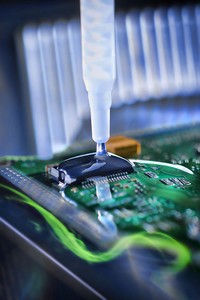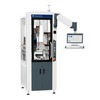Adhesive Bonding Instead Of Welding Or Bolting
Featured Product from Scheugenpflug, Inc.

Adhesive bonding involves the use of adhesive, like glue, to form a material bond between two or more assembly parts. In addition to regular applications, hybrid processes, in which the adhesive bond includes another function such as sealing or heat dissipation, are gaining importance. Traditional joining methods such as welding or bolting are progressively being replaced in industrial applications by efficient automatic adhesive bonding processes, since these processes provide a number of advantages such as part weight reduction or simplified parts handling.
Adhesive dispensing systems essentially execute two automated work steps: applying the adhesive and then fitting the parts together (such as a cover and housing). In industrial applications, the adhesive points or lines frequently have to be placed at precisely defined locations on or inside the assembly part. For this reason, non-flowing high-viscosity 1C or 2C adhesives based on polyurethane, silicone, or epoxy are commonly used. However, depending on the application and which bonding properties are required, low-viscosity adhesives and materials can also be selected.
With the establishment of new material combinations and the implementation of more demanding designs, in recent years and decades adhesive bonding has become a key manufacturing process for a number of manufacturers. Many consumer electronic devices would quickly experience functional failures without working adhesives. Adhesives even have a solid position in the aerospace, lighting, electrical, electronics and automotive industries: A modern car contains about 15 kg to 18 kg of adhesives which are used for purposes such as potting and bonding chips and sensors, reinforcing the car body and attaching vehicle interior components. Even over 700 kg of adhesive are used to attach rotor blade half shells in the wind energy sector. Depending on the type of adhesive used, curing takes place under the influence of UV rays, temperature (oven systems, IR rays, heated tools), moisture or pressure.
Established joining methods such as bolting, welding and riveting have increasingly been supplemented by efficient bonding processes using adhesives in recent years. They have even been eliminated completely to a certain extent, with the catch phrase "adhesive bonding instead of welding or bolting". This change is for a good reason: Adhesives can be used to join parts without negatively impacting or even damaging them like riveting or welding can. In light of this, it is often described as the "joining technology of the 21st century".
The advantages of this process are clear: Through adhesive bonding, both the surface and fine structure of the parts to be bonded remain unchanged, which is a key criterion in terms of the mechanical, aesthetic and aerodynamic properties of a surface or workpiece. In lightweight construction, highly functional adhesives significantly reduce the part weight and energy consumption and prevent galvanic corrosion. Hybrid processes are becoming more important in industrial applications. These are combined joining technologies that provide a durable adhesive bond while at the same time seal the joint, for instance. Even the use of thermally conductive adhesives can be placed in this category, since in addition to ensuring that the assembly parts connection is stable, they also provide effective heat dissipation. Adhesive and glue systems adapted specifically to the application also make it possible to implement shorter cycle times by applying the adhesive faster and through simplified parts handling thanks to flexibly adjustable opening times and reactivities. Through sophisticated material formulations, it is even possible to save time and money by joining and further processing parts on site and only fully curing the adhesive or glue at the time the parts are shipped.
The complexity of these processes is frequently underestimated. To make sure that effective, lasting adhesive bonds can be achieved – particularly for safety-related applications – in addition to purely material application and the subsequent joining process, the upstream and downstream process steps also need to be taken into account. These include workpiece designs suitable for the application, cleaning and pretreatment processes as well as appropriate curing processes, including attaching the parts to be joined. You can find the right dispensing machines and process solutions for integrating adhesive bonding processes into a complex process environment here: Custom dispensing systems.
Different CNC-capable adhesive bonding, dispensing and potting cells from Scheugenpflug are available for the precise, repeatedly accurate application of an adhesive along the intended contour:
- The CNCell can be customized to fit your needs thanks to its modular construction. It is used wherever high flexibility is required for medium to large batch quantities.
Learn more about the CNCell
- The LeanCNCell is the perfect solution for automated applications related to small to medium production quantities. It combines all the advantages of the CNC system plus a high-precision axis controller with attractive performance for the price.
Learn more about the LeanCNCell
- The Scheugenpflug ProcessModule can be quickly and safely integrated into new or existing production cells or lines. This ensures that all adhesive-related parameters and processes are perfectly attuned to each other regardless of the other machine components.
Learn more about the ProcessModule
- The gear pump dispensers from Scheugenpflug are ideal adhesive dispensing systems when 1C adhesives need to be applied evenly and continuously to assembly parts. The Dos GP metering systems also work quickly and precisely on complex workpiece geometries. The applicators can be additionally equipped with a special swivel needle if necessary.
Learn more about the Dos GP



